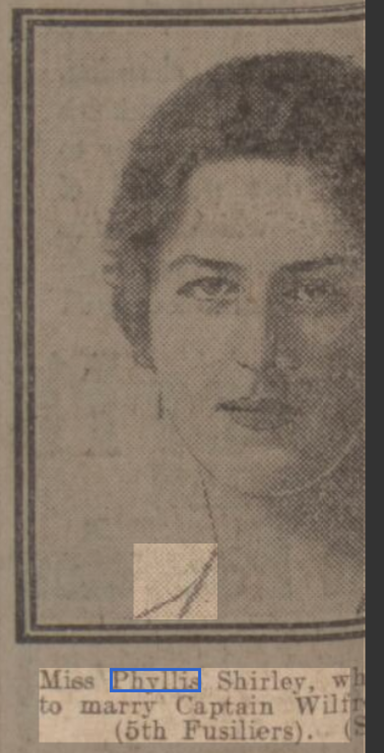WILFRED HERBERT CECIL BROWNLOW
Captain, 2nd Battalion, Attd 12th/13th Battalion, Northumberland Fusiliers
Killed in Action on 28 May 1918 at the Massif de St Thierry
during the Battle of the Aisne. He was aged 28
Buried at Hermonville, Departement de la Marne, Champagne-Ardenne, France

Wilfrid Brownlow
Click to enlarge
Wilfred Herbert Cecil Brownlow was born on 25 October 1889 at Murree in India, part of the Rawalpindi District in the Punjab, now part of Pakistan. He was the only son of Colonel Cecil Barry Brownlow (1864-1935) and Minnie Blanche Brownlow of The Old Well Cottage, Forest Row. His father, a career soldier in the Indian Army and an expert on Afghanistan, had been promoted from Lieutenant to Captain on 23 November 1886. Wilfred probably never lived in Forest Row, but his parents had settled there on Cecil's retirement from the army.
Wilfred was educated at Summerfield School for Gentlemen's Sons in Oxfordshire. He joined the 5th Northumberland Fusiliers as a Second Lieutenant at Dover in 1909, where he was later awarded the British Humane Society Medal for saving a life there. He was promoted to Lieutenant on 9 March 1912.
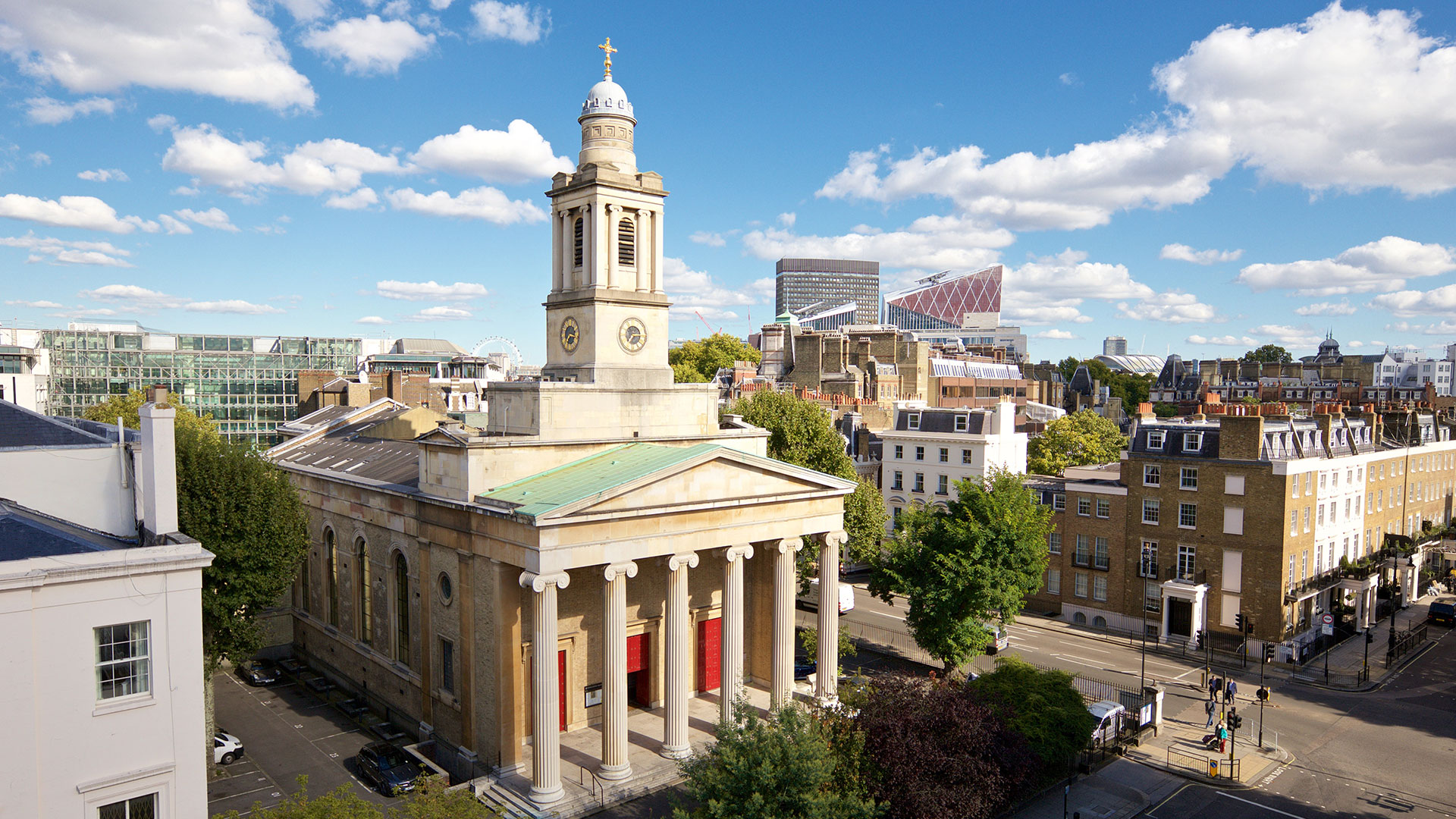
St. Peter's Church, Eaton Square, Belgravia
Click to enlarge
He married Phyllis Shirley in June 1916 at St Peter's Church, Eaton Square, in Belgravia, London SW1. At the time of the 1911 census, she was living, aged 18, with her widowed mother at Hanover Square, Mayfair, London W1. They had seven servants, including a cook and a butler. Her father, who died in 1904, had been a landowner in Warwickshire. Phyllis died in 1982, aged 89.
(above left) Engagement of Phyllis Shirley to Captain Wilfred Brownlow
announced in the Daily Record, 15 August 1915.
(above right) Wedding report in the Warwick & Warwickshire Advertiser, 10 June 1916
Click to enlarge
After returning from India with his regiment Wilfred had served on the Western Front from December 1914 onwards. He was badly wounded on 22 February 1915, probably between Bailleul and Hazebrouck, where the Northumberland Fusiliers were deployed after disembarking from Le Havre between 19 and 22 January 1915. He was wounded with a gunshot wound to the head and was treated at Number 3 Casualty Clearing Station and on Number 4 Ambulance Train. He was listed as "Wounded" on the Casualty List issued by the War Office from 23 February 1916. He was entitled to wear a "Wound Stripe" as authorised under Army Order 204 of 6 July 1916.
Wilfred only returned to the front on 15 May 1918, and was killed organising a rearguard action on 28 May 1918 at the Massif de St Thierry. A fellow officer reported that "he was hit by a piece of shell and knew at once he was dying and said 'Give my people my love and tell them I died with a smile on my face' ".
The Rector of St. Mary's Church, Stoke D'Abernon, Surrey, was Wilfred Brownlow's uncle, and he made sure his injuries and death were recorded locally. The item below reporting the wounding of Wilfred at Ypres is taken from the Surrey Advertiser of 27 February 1915:

Click to enlarge
In July 1918 the parish magazine of St. Mary's recorded the death of Captain Wilfrid Brownlow as follows:
Captain Wilfrid Brownlow, Northumberland Fusiliers, only son of Colonel and Mrs Cecil Brownlow. He joined the 5th Fusiliers in 1909 at Dover, where he gained the Royal Humane Society vellum certificate. He returned from India in December 1914, with his regiment. He was dangerously wounded in an attack to retake a trench at Ypres on 21 February 1915. He joined the RMC [Royal Military College], Sandhurst, as Staff Captain, in August, 1916. He left for the front on May 15th last, and joined the Northumberland Fusiliers on the 25th. His Major writes: 'on 28th May I was in command of a composite force fighting a defensive action. He was mortally wounded by a piece of shell during the action. He was perfectly wonderful amongst the men'
The following report was published in the Kent and Sussex Courier on 21 June 1918:
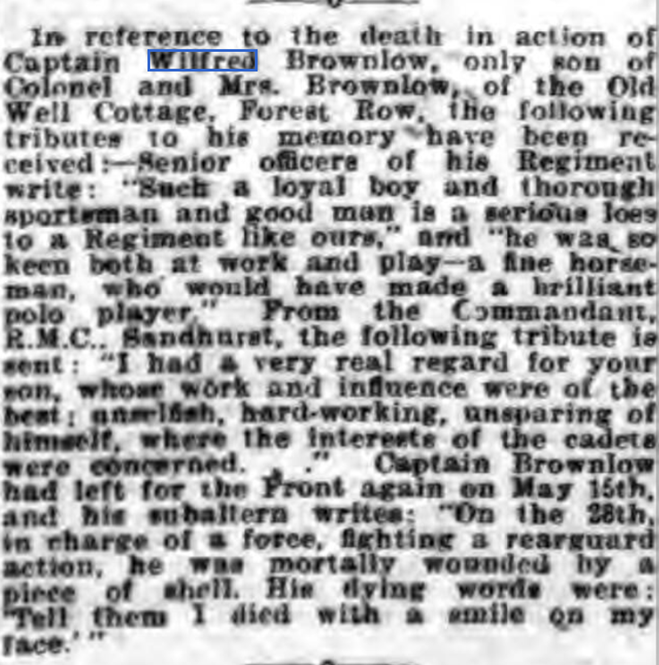
Click to enlarge
Wilfred was buried in Hermonville Military Cemetery, Marne, about 6½ miles north-west of Reims. This originally contained, on the west side, 407 French and 99 German graves, but these were later removed. The British graves are those of soldiers from the United Kingdom, mainly of the 21st Division, who fell in May and June 1918, and were reburied here after the Armistice.
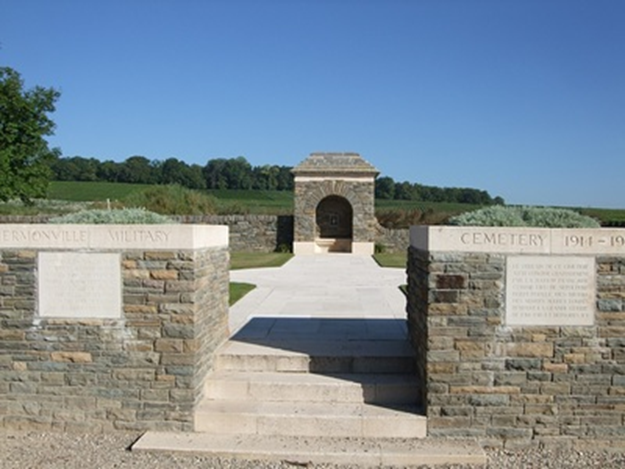
Hermonville Military Cemetery
Click to enlarge
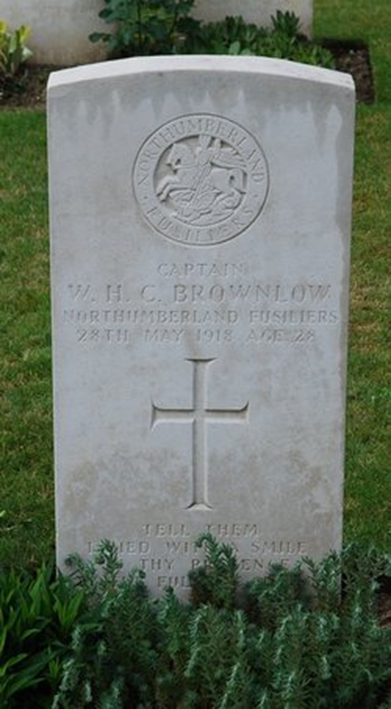
Captain Brownlow's gravestone
Click to enlarge
The 12th (Service) Battalion, 2nd Northumberland Fusiliers was formed at Newcastle-upon-Tyne in September 1914 as part of K3 and came under the orders of 62nd Brigade, 21st Division. It landed in France in September 1915. On 10 August 1917 it amalgamated with the 13th Battalion, becoming 12th/13th Battalion.
In 1918 the battalion served in the the Battle of St. Quentin, the First Battle of Bapaume, the Battle of Messines, the Second Battle of Kemmel, and the Third Battle of the Aisne (27 May-6 June 1918), in which Captain Brownlow was killed.
When Captain Brownlow died his address was given as Old Well Cottage, Forest Row — his parents' address. He left £6,506 9s. 10d. in his will to his father. Probate was granted on 15 October 1918.
Colonel Brownlow subsequently collaborated with the British Legion on a proposal to erect a war memorial at Forest Row army camp on Ashdown Forest, which was agreed to by the Conservators of Ashdown Forest. The memorial, pictured below, was unveiled on 4 April 1926. It is now listed by Historic England.
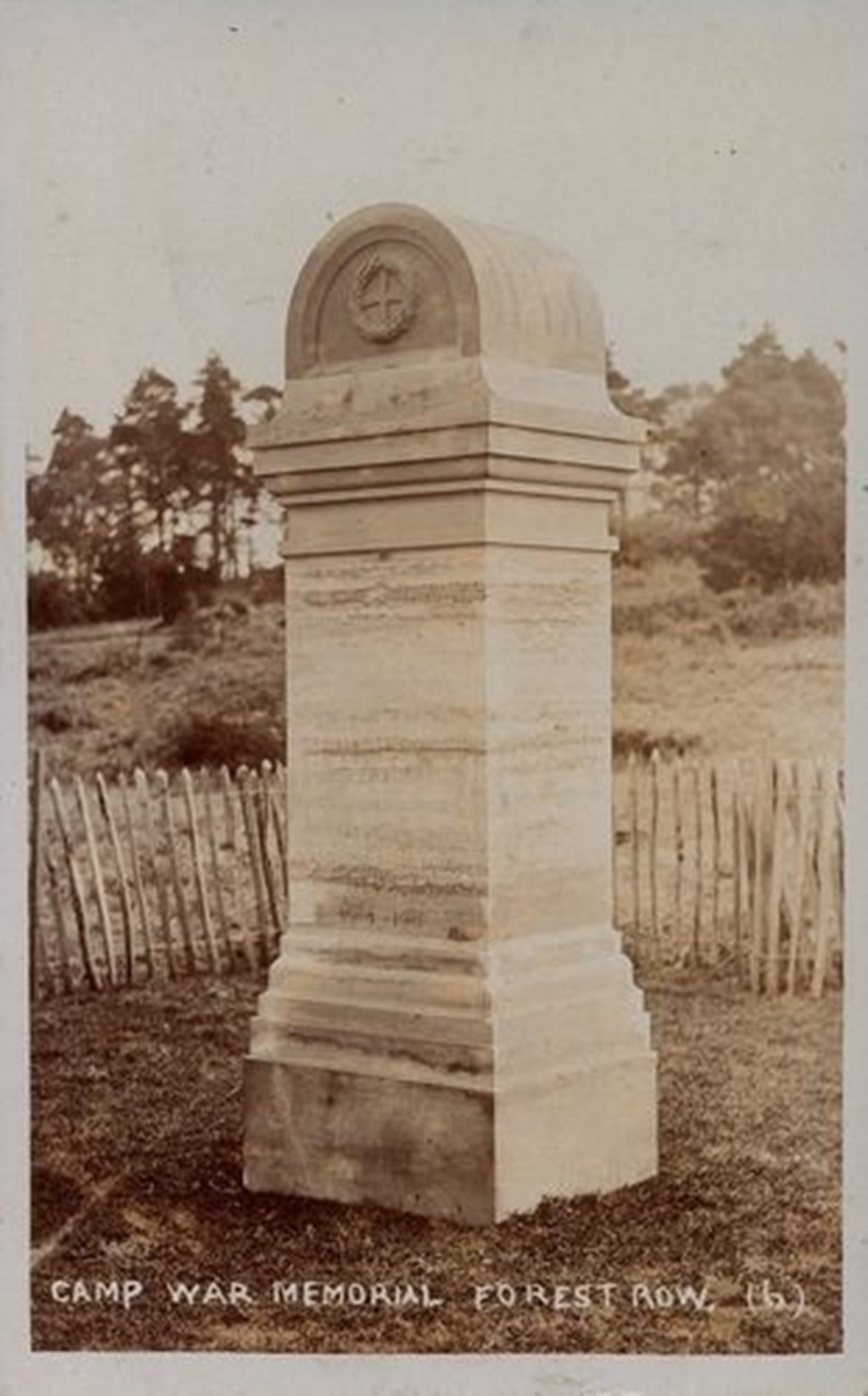
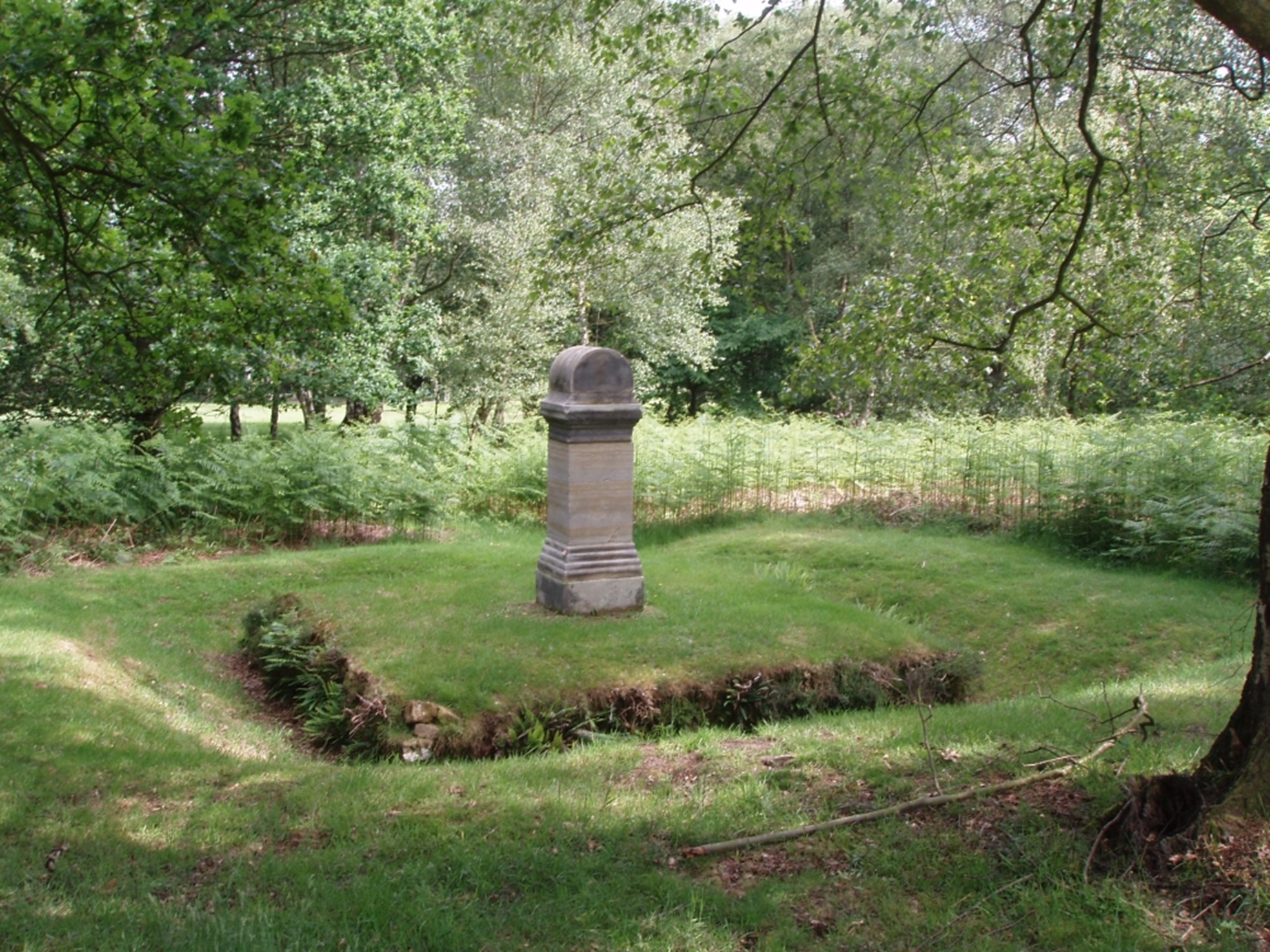
The Forest Row Army Camp War Memorial on Ashdown Forest
Click to enlarge
Carol O'Driscoll
First published 8 September 2018
Last updated 29 October 2021


